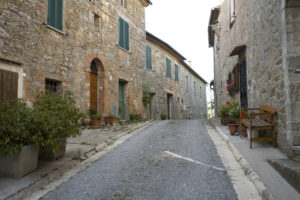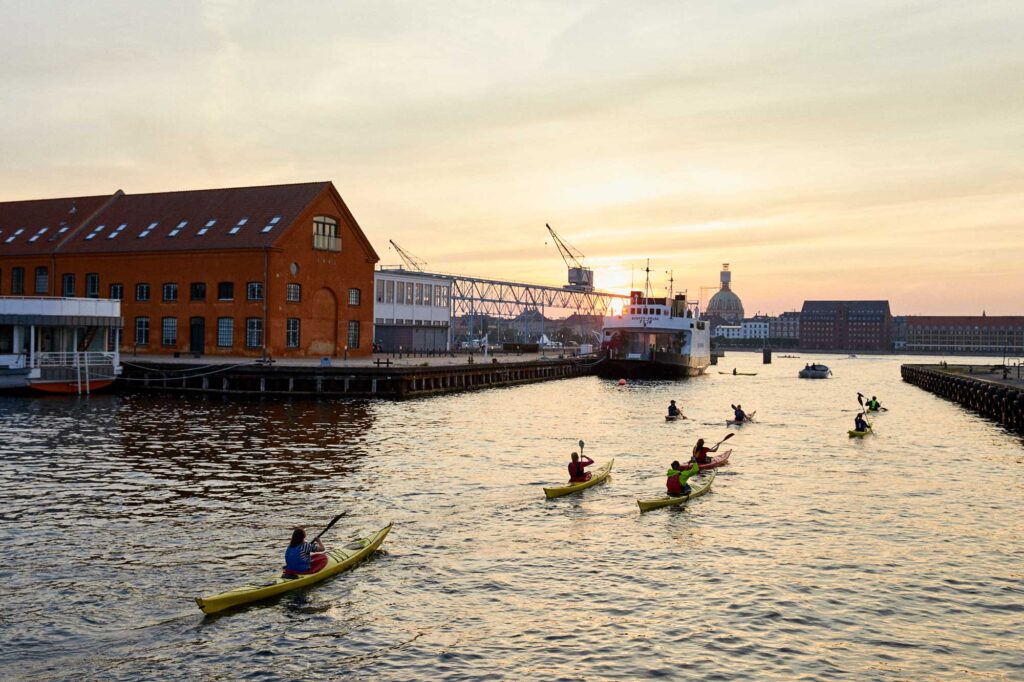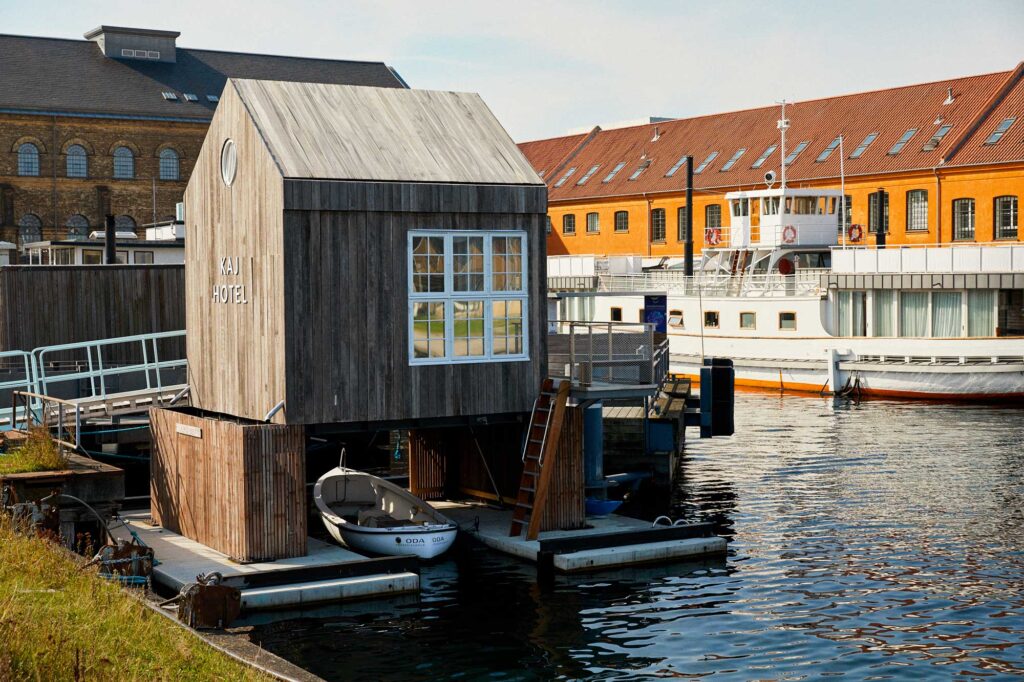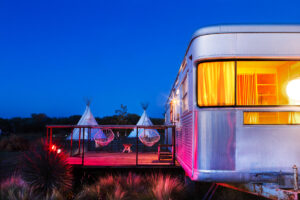
Monteverdi Tuscany – Boutique Hotel in Italy
Castiglioncello del Trinoro is a 900 year-old village in the Val d’Orcia region of Tuscany where Monteverdi Tuscany began.
Denmark
Abbigale Shi August 2, 2021
Barbara von Haffner and Toke Larsen are the owners of a single bed-and-breakfast-style home away from home located on the docks of Copenhagen, Denmark. Built sustainably and almost entirely from repurposed materials, this destination was created to share the joys of living in a houseboat at the heart of a city. It is a hotel that takes on a life of its own.
A stay at the KAJ hotel also comes with the recipe and ingredients for a traditional Scandinavian porridge created by Danish chef Bo Lindegaard. KAJ encompasses the practice of Danish coziness: hygge. Guests will find themselves immersed in culture while also experiencing the collection of moments that make up life on a houseboat.
Mood of Living: What is your hometown?
Barbara von Haffner: Copenhagen.
Toke Larsen: Copenhagen
MoL: Where did you go to school?
BvH: Herlufsholm Bordingschool and the University of Copenhagen.
TL: I studied engineering at Danish Technical University (DTU) and received an MBA from University of Reading.

MoL: Before your current occupation, what did you do?
BvH: Due to the small size of KAJ Hotel (one room), I still run my own research and analytics company doing qualitative market research. KAJ is something we do as our “family hobby.”
TL: I am a project director for real estate investment and developments for AP Pension, a pension fund investing part of their fund in real estate in Denmark.
MoL: Where did you two meet?
BvH: On Toke’s hand-built raft! We have a mutual friend, who invited me out “sailing in the canals of Copenhagen” on one of his friend’s raft. I thought it was the most random idea, but it turned out when Toke picked us up that I actually had met him a year and a half previously when Jacob (our mutual friend) had brought Toke along to a party I hosted. But it was on the raft that the magic happened.
TL: Yes, she is right. We were out sailing on the raft having fun with friends and enjoying the summer vibes.
MoL: What is it like to live on a houseboat? How did living on a houseboat influence your decision to build KAJ hotel?
BvH: This was the actual influencer! When you tell people you live on a houseboat, so many people respond that this has always been a dream for them. Then we started putting our own on Airbnb when we went traveling — and all the people renting it wrote the most personal reviews and left us presents and personal thank-you notes. So Toke came up with the idea that we should build “the world’s smallest houseboat” only to rent it out.
TL: The idea came out of a mix of living on the houseboat and wanting to share the super nice moments, combined with a desire to build a tiny house. The smaller the project, the faster a real estate asset will give a return. Therefore, the project needed to be small. By the end, it was a lot more expensive than expected, so the plan was not bulletproof. But the tiny house and all the just-a-little-more-than-budgeted details are all worth the extra cost and time.
MoL: What is KAJ Hotel’s mission?
BvH: To share the experience of living on the water — smack in the middle of one of the greatest capitals in the world, with as many likeminded people as possible. And to give our guests the “pure essence” of living on a houseboat. Great views, peaceful mornings on gentle waves, feeling the nature and good coffee (or wine).
TL: To give all guests the opportunity to try living on a houseboat. And at the same time doing it on a great design built with Scandinavian materials. It’s unique to enjoy the sunsets and wake up to the sound of water around the houseboat.
MoL: What sustainable initiatives do you implement in your business? How do these initiatives positively impact your community and guests?
BvH: Hopefully our guests will “live in the moment” when visiting KAJ. There is no TV and the place is not suitable to work from, as the rocky feeling will make you seasick if you sit and stare into a screen. The design of the room — with the panoramic windows and the balcony — invites you to just sit and enjoy the peace and quiet, watching the kayaks and rowers cut silently through the water. We also have kayaks you can borrow. It’s quite meditative.
The place is predominantly built from recycled materials (Toke will talk more about that), and everything we put inside is organic. All fabrics, bed linen, sheets, curtains and towels are organic and classified as eco-friendly. All food and beverages are organic and locally produced (to the extent where possible the wine is from Germany and the coffee is from Ethiopia).
We wash all our bedlinen ourselves, and everything is air-dried. First of all, because we have no tumbler from a sustainable point of view and because it gets so crisp from hanging out to dry. The water tank is only 60 liters — we physically encourage our guests to take short showers.
TL: We love recycled materials. We have used several really nice long-lasting products. The steel frame for the pontoon joint and the frame for the house is built using old railway poles from the Danish railways. The façade cladding and roof are from second-hand terrace planks — probably 10 to 15 years old. Its hardwood will last a long time as a façade. The Dinesen planks are low quality. They have more variation than their prime product but are very beautiful. The stairs to the pontoon used to live on a ship. The windows are from a pre-navy house that has been converted back to the original design with door openings. We bought some of these 100-year-old windows.
MoL: What materials did you use to build KAJ Hotel?
TL: Concrete for the floating pontoons, steel for the frame, and the house is built from wooden frame constructions. We used plaster cladding for the white surfaces, and the floor and wall are solid Douglas wood. The bathroom has burned tiles, handcrafted from the United Kingdom. The plumbing is Vola solid brass. The kitchen is a mix of Ikea products and built-to-fit carpentry, including the brass top. The bed is built from solid Douglas flooring.
MoL: How does KAJ Hotel collaborate with local businesses and connect with its community?
BvH: We have a collaboration going on with some of the local restaurants, which are also very focused on locally produced ingredients. We sell Gin and Whiskey from the very local distillery Copenhagen Distillery in our minibar. They have a very sustainable profile, and their Gin and Whiskey are renowned by experts worldwide.
We are also very proud of our excellent freshly-ground coffee from a Copenhagen-based coffee roaster, Impact Roasters, who buy their beans directly from Ethiopian farmers using the minimum involvement of middlemen and no engagement of branch traders. They also ensure long-lasting positive effects for the communities that grow their beans, creating jobs in south Ethiopia.
Lastly, we have a collaboration with the high-end Danish skincare brand Scandinavisk. All of their products are made in Denmark, and they are a Certified B-Corporation, meaning they meet the highest standards of social and environmental impact.
TL: We used a local blacksmith to weld the steel frame. Most materials are sourced second-hand locally, but the new ones are sourced in nearby shops. Special materials are bought online. The cleaning company, Best Wish Cleaning, is a new company run by a very strong woman from Uganda. They are super service-minded and a joy to work with since we need big flexibility in order to accommodate our customers’ needs. We have helped the owner, Teddy, a great deal in setting up her business here in Denmark.
MoL: What do you hope guests take away from their stay at KAJ Hotel?
BvH: That they have connect with nature and themselves. We have a guestbook, and most of the reviews are about all their impressions regarding the senses they have experienced during their stay: the sound of the water and the local birds, seeing the morning light, smelling the freshly made coffee, tasting the porridge and feeling the cold water if going in for a dip.
TL: The feeling of enjoying the small things in life, such as looking out over the water. That’s the best part of living on a houseboat: the feeling of nature nearby. I love it.
MoL: What does the future of KAJ Hotel look like? Do you plan on expanding?
BvH: No. We are discussing this a lot, but I fear that the unique feeling of being alone with the sea will be challenged if there are too many “KAJ Hotels” floating around. Also, it makes our life so much easier that KAJ Hotel is right next door to our own houseboat. If the cleaners have forgotten something, we can easily go in and fix it. If the gangway is making an annoying sound, we are there to fix it. If something breaks, we discover it right away. The logistics of running too many KAJ Hotels around Copenhagen, or even in Scandinavia, would not necessarily make it a better business or experience. But we are discussing it.
TL: Yes. The boat is designed as a concept, and we could build more. The design of the house can be changed easily within the same dimensions and weight. This is a very important design spec on the water. But yes, I agree with Barbara that many KAJ Hotels together is definitely another feeling and another concept. There might be room for this somewhere in Denmark or another place in the world.

MoL: What advice can you give to someone interested in creating their own sustainable travel destination?
BvH: Don’t do it for the money! It’s a lot of hard work, and there are rarely any easy fixes or standard solutions. You really need to be engaged from a personal perspective to make the time and effort you put into it worthwhile.
TL: Make sure that the location is great, and do it so that you would like to stay there yourself for a very long time. Whenever we were in doubt, we followed our guts and chose the more challenging way.
MoL: What does the Danish word hygge mean, and how does it apply to KAJ Hotel?
BvH: This is a very good question! Hygge is about being present with yourself or people you like and love. Hygge is a feeling you get when you take a break and enjoy being in the simple moment away from a busy lifestyle. Often people misunderstand the concept and think that Scandinavian design is the same as hygge. This is ironically not the case at all. Scandinavian design and decor are simple, light and pure. These three things have nothing to do with hygge. An old dark cabin with a massive bookshelf, an old armchair and a worn-out woolen rug in front of a fireplace is a classical “hygge look,” but you cannot rent something like this out. People would find it unhygienic, and perhaps this is only “hyggeligt” if you know the people (often your grandparents) living there.
With KAJ, we have tried to combine the simple Scandinavian design culture with the cozy cabin hygge atmosphere. Our panoramic windows that provide the Scandinavian feel/light to the room are not massive glass panels but 100-year-old small barred windows, with light airy curtains adding the hygge element without compromising the Scandinavian look. The bed is made of light oak boards and made up with TEKLA fabrics, a tribute to the Scandinavian simple design. Yet the bed is hand build and rather chunky (cabin style) with lots of pillows adding hygge. The kitchenette is made of brass, a reminder of the maritime tradition, which is also an important element of hygge. In other words, KAJ is hygge due to the fact that its décor, design and location focuses on the presence of being there. The house is small, so you actually need to be with the people you are there with. You can’t avoid noticing how they feel and behave. It’s about giving the people you are there with your full attention.
Often hygge is about fire. We would have loved to have a small fireplace, but that is not very sustainable or very practical in a small room that would very rapidly get overheated. But there are candles and a brass candleholder, so our guests can easily achieve the hygge feeling. We also have the “Hygge Game” lying in the window panel, which is a conversation game that allows friends and family to share stories and discuss the big and small things in life. The fact that you can make your own porridge in the morning (all ingredients are provided by us) is a hygge element. It’s a presence thing to make a porridge for your loved one in the morning as opposed to going down to a restaurant and taking food from a buffet. Our porridge has seven different spices, so it’s very intense, which again keeps you focused on the moment. Not to mention, everything tastes better when you have been in the water for a quick morning dip!
MoL: Do you lead an eco-conscious lifestyle, and if so, how?
BvH: Our lifestyle is very similar to the one we try to show our guests. We are not fanatics. Or perhaps I should say, we are also “double moral” like the vast majority of people. We try to make sustainable choices in our everyday lives. We ride our bikes to all possible destinations, and we buy organic and locally. We try to avoid plastic crap consumerism. We buy little new clothing for both ourselves and our kids (for whom we are lucky to receive so many second-hand clothes). We pay attention to our carbon footprints, invest our pensions in green options and buy as many things as possible second-hand. But we can always do better. We all enjoy skiing, and my best friend lives in New Zealand, and has taken me there by plane four times already. That’s a thing very hard to compromise on. But after having kids, we tend to stay more at home/in the country. Every year we go sailing for a week with the whole family, which, in my opinion, must be one of the most sustainable forms of travel. (We actually sail and use the engine as little as possible.) We love the ocean.
TL: We do. I like kite surfing and riding a mountain bike. Our boat is heated with a heating pump that takes the heat out of the sea. We always try to buy second-hand or recycled, maybe even try to build stuff ourselves. My design for a new sofa of steel and wood is on the to-do list. We bike, and eat healthily. But as many others, we also enjoy alcohol and meat and use materials that are not all 100% sustainable.
Photography courtesy of Kaj Hotel

Castiglioncello del Trinoro is a 900 year-old village in the Val d’Orcia region of Tuscany where Monteverdi Tuscany began.

Liz Lambert’s El Cosmico in Marfa, Texas, is a unique hotel and campgound that focuses on nature and tranquility.